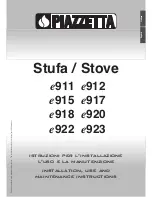
11
Temco VF36RN/RNH/RP
78586
When installing this fireplace at an elevation above
2,000 feet, it may be necessary to decrease the input
rating by changing the existing burner orifice to a
smaller size. Input should be reduced four percent
(4%) for each 1,000 feet above sea level, unless the
heating value of the gas has been reduced, in which
case this general rule will not apply. To identify the
proper orifice size, check with the local gas utility.
Consult your local gas utility for assistance in determin-
ing the proper orifice for your location.
Gas Pressure Check
The gas inlet pressure specified in Table 1 is the
pressure where the field-installed gas line connects to
the gas control. This is measured at the inlet test port
on the gas valve in the appliance. Ensure that pressure
is as shown in Table 1.
The manifold pressure is controlled by a regulator built
into the gas control and should be checked at the
pressure test points located between the flame adjust-
ment knob and the control knob at the front of the
Table 1
Gas Inlet Pressure
Natural
Propane
Max.
14.0” w.c.
14.0” w.c.
Normal
7.0” w.c.
11.0” w.c.
Min.*
4.5” w.c.
11.0” w.c.
Regulator Pressure
3.5” w.c.
10.0” w.c.
*Minimum inlet supply pressure for the purpose of input adjustment.
valve. The pressure connections accept 1/4” I.D. hose
or tubing.
The pressure should be checked with the appliance
burning on high (highest setting) and all other gas
appliances turned on. One must then read the manom-
eter and if pressures are not as specified in Table 1,
then the inlet pressure must be adjusted.
After measuring the pressure, tighten the screw in the
pressure test port and check for leaks. Replace the
control box cover and the two screws.
NOTE: To determine the size of the branch gas line from the main gas line to the fireplace, enter the tables below (for iron
pipe or copper tubing) using the distance from the gas meter or second stage regulator to the furthest appliance on the
gas system. Select a pipe or tube diameter which has enough capacity to meet the maximum input requirement of the
fireplace. Regardless, do not use less than 1/2" diameter for the branch line. For any distances required longer than
shown in these tables, refer to the National Fuel Gas Code.
NOTE: There may be a local gas utility requirement specifying a minimum diameter for gas piping. All units require a 1/2 inch pipe
connection at the gas valve.
Gas Line Pipe Sizing
CAPACITY OF PIPING
Cubic Feet per Hour based on 0.3" w.c. Pressure Drop
Specific Gravity for Natural Gas - 0.6 (1000 BTU/Cubic Foot)
Specific Gravity for Propane Gas - 1.6 (2550 BTU/Cubic Foot)
Length
Nominal Inches for Iron Pipe Sizes (1,000s BTU/hr)
of
1/2” D
3/4” D
1” D
1
¹⁄₄
” D
1
¹⁄₂
” D
Pipe
Natural
Propane
Natural
Propane
Natural
Propane
Natural
Propane
Natural
Propane
20’
92
143
190
296
350
546
730
1135
1100
1711
30’
73
115
152
237
285
444
590
918
890
1385
40’
63
97
130
202
245
380
500
778
760
1183
50’
56
87
115
179
215
334
440
683
670
1043
60’
50
79
105
163
196
304
400
622
610
949
70’
46
71
96
151
180
280
370
576
560
872
90’
40
61
84
130
160
250
320
497
490
763
100’
38
59
79
122
150
235
305
474
460
717
Outside Diameter Copper Tubing, Type L (1,000s BTU/hr)
Tubing Length
1/2”
5/8”
3/4”
7/8”
Feet
0.43
0.545
0.666
0.785
10
110
206
348
536
20
76
141
239
368
30
61
114
192
296
40
52
97
164
256
50
46
86
146
224
60
42
78
132
203
80
36
67
113
174
100
32
59
100
154
WARNING: Use only internally tinned copper tubing. If correct copper tubing is not used, tubing can deteriorate and
develop gas leaks.
CAUTION: If the appliance’s operating pressures
are not checked and adjusted, improper combus-
tion may result in soot being produced.










































